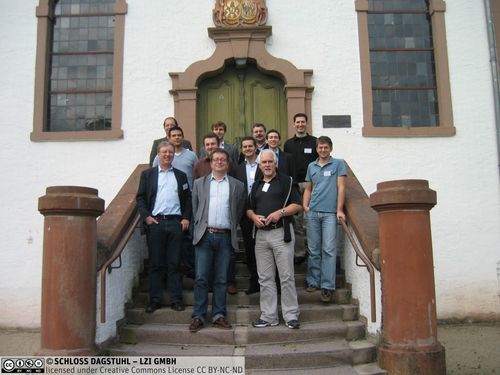Dagstuhl-Perspektiven-Workshop 08393
Virtual games, interactive hosted services and user-generated content in Web 2.0
( 24. Sep – 27. Sep, 2008 )
Permalink
Organisatoren
- Thomas Hoeren (Universität Münster, DE)
- R.K. Murti Poolla (University of Hyderabad, IN)
- Gottfried Vossen (Universität Münster, DE)
Kontakt
Presse/News
-
Web 2:0: Möglichkeiten werden zu wenig genutzt
Bericht von Karten Reimers in MONITOR-Österreich 12/2008 -
Urheber 2.0: Was tun, wenn keiner kauft?
Bericht und Video im Auftrag des ZDF in Kooperation mit dem Handelsblatt 12.12.2008; Konzeption Fiete Stegers -
Urheber 2.0: Jeder Nutzer ein Pirat?
Bericht und Video im Auftrag des ZDF in Kooperation mit dem Handelsblatt 12.12.2008; Konzeption Fiete Stegers -
Im Web 2.0 sind viele juristische Fallstricke ausgelegt
Bericht von Gerd Martin in Computer Zeitung Online, 29.10.2008 -
Rechtsfragen im Web 2.0
Interview von Simone Haug, Institut für Wissensmedien, mit Prof. Dr. Thomas Hoeren, Uni Münster; 20.10.2008 -
Die letzten Tage waren interessant
Blog von Wolfgang Back, Computerclub Zwei - Veröffentlichung der Pressemitteilung durch
-
Wo im Web 2.0 die juristischen Fallstricke liegen
Press Release 19.09.2008 (German only).
Recently, almost everything seems to have become “2.0”, be it music, gadgets, health, entertainment, business, Silicon Valley, countries such as India, the family, and, most notably, the Web. 10GB of “user-generated content” is created in the World-Wide Web daily (see Ramakrishnan and Tomkins, 2007), that is, more than five times the amount of content created by professional Web editors. Web 2.0 has rapidly become a label that everybody using the Internet and doing business through it seems to be able to relate to; what it primarily stands for is the transition of the Web from a medium where people just read information to a medium where people both read and write; in other words, the Web meanwhile heavily benefits from user contributions and user-generated content (UGC) in a variety of media forms. This has been enabled by technological advances that nowadays make it possible for users to easily employ services offered on the Web and to embark on tasks that have previously been reserved for specialists.
UGC can primarily be observed in the consumer area, but is also entering enterprises. Especially in the former, numerous legal issues arise, which is demonstrated by the large number of cases from this field that courts of laws have to deal with recently. This situation is due to a number of reasons, including the fact that legal restrictions are often ignored, or that users are unaware of the laws they may be or are violating. The goal of this manifest, which contains the findings of a Dagstuhl Perspectives Workshop held at Schloss Dagstuhl, Germany in September 2008, is to shed some light on the interplay between law and Web 2.0 and to discuss a number of questions and issues that urgently deserve clarification.
This manifest is organized as follows: Section 2 presents, in a nutshell, the technical side of Web 2.0; Section 3 then presents the legal side as it pertains to Internet, media, and related laws. Section 4 contains a to-do-list summarizes the most pressing issues to be resolved.
- Justus Broß (Hasso-Plattner-Institut - Potsdam, DE)
- Mark Cole (University of Luxembourg, LU)
- Stephan Hagemann (Universität Münster, DE)
- Thomas Hoeren (Universität Münster, DE) [dblp]
- Daniel Hötte (Universität Münster, DE)
- Matthias Jarke (RWTH Aachen, DE) [dblp]
- Viktor Kaufman (SAP Research - Karlsruhe, DE)
- Christlieb Klages (Anwaltssozietät Hertin, DE)
- Alexander Löser (TU Berlin, DE) [dblp]
- Giuseppe Mazziotti (Nunziante Magrone - Rome, IT)
- R.K. Murti Poolla (University of Hyderabad, IN)
- Ralf Schenkel (Universität des Saarlandes, DE) [dblp]
- Gottfried Vossen (Universität Münster, DE) [dblp]
Klassifikation
- web
Schlagworte
- Internet
- Web 2.0
- law


